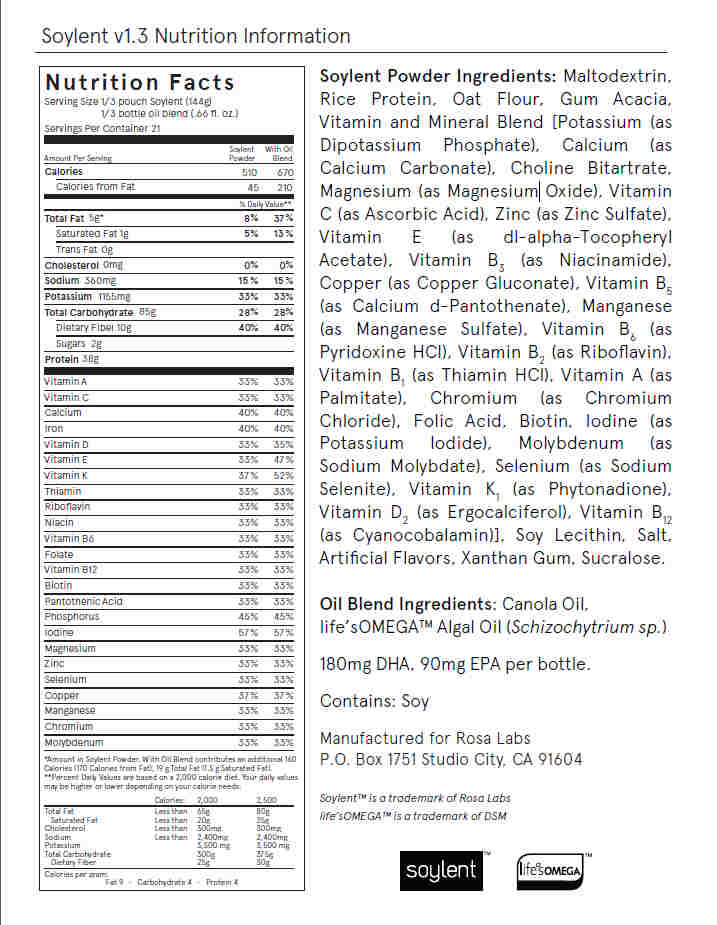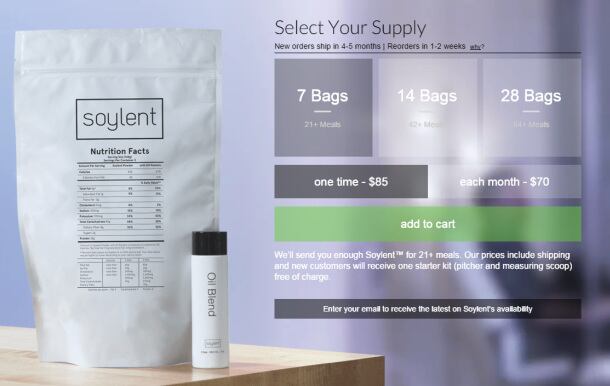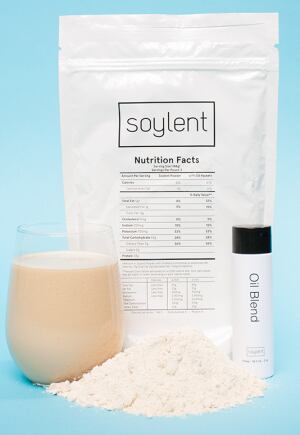Space porridge jokes aside, the numbers don’t lie, said CEO Rob Rhinehart in a blog post after announcing that venture capital firm Andreessen Horowitz is leading a $20m investment in Soylent with participation from Lerer Ventures, Index Ventures and individual investors including David Friedberg, CEO of The Climate Corporation.
And since the seed round in 2013, Soylent (classified as a food, not a supplement, by the FDA) has sold one million daily pouches (three million meals) and now generates “millions of dollars per month in subscription revenues”, said Rhinehart, who has raised more than $3m on CrowdTilt in what he claims is the largest crowd-funded food project in history.
“This is a huge leap forward for our company.”
The focus will be on dramatically reducing the price of Soylent
The company - which Rhinehart claims is already profitable - will put the cash into long-term R&D and “significantly expanding” its manufacturing and shipping capabilities (it’s made by Rosa Labs) to meet demand for its "neutral-tasting" meals, which promise to deliver all the vitamins, minerals and macronutrients you need for less than $10 a day.
“This process has already begun with two new manufacturers that will ramp up our production to more than fifty times its previous rate allowing us to vigorously tackle our order backlog [there is currently a 4-5 month delay for new customers] while working toward imminent real-time shipping fulfillment,” said Rhinehart.
Another area of focus according to Andreessen Horowitz general partner Chris Dixon, who is joining Soylent’s board, “will be on dramatically reducing the price of Soylent, from the current $3 per meal to a fraction of that”.

‘Contrary to the caricature of Soylent as a complete food replacement, it mostly replaces unhealthy meals’
But who is actually eating the stuff, and isn’t food fatigue a huge problem, given that adding a packet of powder to a vial of oil (a combination of canola oil and algal oil delivering the omega-3 fatty acids EPA and DHA) and adding water to make dinner every night seems, well, pretty joyless, not to mention nutritionally suspect?
According to Dixon, that’s missing the point. While you could eat the product exclusively, most customers don’t, he observed in a recent blog post.
"If you read the Soylent forums you’ll see that – contrary to the caricature of Soylent as a complete food replacement – it mostly replaces unhealthy meals”.

The website also notes that “Soylent is more of a healthy, convenient and cheap option available as a default when you don't have the time, inclination or money to cook or eat at a restaurant. It can be consumed for every meal, 90% of meals, once a day, or whatever you decide.”
Meanwhile, the community that Soylent has built up via its discussion forum and DIY Soylent site (where users share their own Soylent recipes) is key to its value, said Dixon.
How many other brands have such a clear understanding of who is buying their product, how they are using it and where they want it to go next?
“Many investors decided not to invest in GoPro because they saw it as a camera company, and camera companies generally get quickly commoditized,” added Dixon. “However, investors who properly understood GoPro saw it primarily as a highly engaged community of sports enthusiasts, something that is very hard for competitors to replicate.”

If you look at Soylent as just a food company, you misjudge the core of the company
Soylent, similarly, is not just a product, he said, but a “community of people who are enthusiastic about using science to improve food and nutrition. The company makes money selling one version of that improved food (some users buy ‘official Soylent,’ others buy ingredients to make their own DIY Soylent recipe). If you look at Soylent as just a food company, you misjudge the core of the company, the same way you would if you looked at GoPro as just a camera company.”
Notably, Soylent does no advertising and distributes its products solely through e-commerce, he said. “Soylent’s ‘marketing plan’ is to invest in its online community and in peer-reviewed scientific studies. The belief is that the internet has made people smarter, and that the old tactics of selling junk food using clever advertising will be increasingly ineffective.”
I guess this means $20m is no longer tough to come by in the private equity food space
So what do nutritionists and market researchers make of the product?
Rachel Cheatham, PhD, founder and CEO of consultancy Foodscape Group, told FoodNavigator-USA that she was initially surprised to learn that Soylent had attracted such a large investment: “I guess this means $20m is no longer tough to come by in the private equity food space…”

However, the community aspect is tantalizing, she said. “The bigger investment at hand is perhaps not really betting on this liquid meal replacement approach to simplifying nutrition, but rather funding an active, engaged online community of potential subscribers who just want food, health and nutrition to be as simple and easy as possible. The community appears to be rather geek chic too as they dialogue about dextrose equivalents and the like.”
Meanwhile, much of the investment money “may wind up going towards Soylent formulation variations to ensure the taste is there, plus getting rid of unwanted ingredients like artificial flavors and sweeteners,” she speculated.
However, food fatigue still seemed like a major barrier given the “human need for taste, variety, chewing and experiencing the smells, flavors and textures of a varied diet”, she said.
“This is proven out already as the DIY Soylent community is already so active. They are doing things like taking Soylent and using masa harina as the base and calling it the tortilla version. It won't be long till that Soylent user is just back to eating burritos no doubt.”
Where are the phytonutrients?
From a nutritional perspective, meanwhile, she said, “They have taken maltodextrin, rice protein and then some canola and algal oil all mixed in with a bunch of vitamins and minerals. This is basically nutrition reductionism from a product perspective in that the macronutrients and micronutrients are theoretically more or less covered, and one serving is conveniently made to offer 33% of the nutrients inside a third of the pouch and oil. So basically three a day and you’re done. [Click here for the complete ingredients list and Nutrition Facts.]
“If only it were that easy. I mean think of all the phytonutrients you get from eating fresh whole produce - isothiocyanates, anthocyanidins, and beta-cryptoxanthin. None of those are even in here.”

Datamonitor Consumer: There is something about this that reminds me of Crossfit
Tom Vierhile, innovation insights director at Datamonitor Consumer, said Soylent will “have to be creative to stick around long-term and avoid being a flash in the pan”, and wondered if "the easy ability to raise money for this may be evidence of a food bubble".

However, the community aspect is exciting, he added: “There is something about this that reminds me of Crossfit, for some reason. That exercise regimen seems to be very community-based and there are shades of that with Soylent.”
Drinkable snacks, meanwhile, are gaining momentum in the US, said Vierhile, “with breakfast drinks becoming trendy as well as blender-type drinks that can either supplement or replace a meal. It would be interesting to see how blenders did this holiday season – they were one of the big items that stores like Target were pushing. This plants the seed of liquefied meals with the consumer.”
Drinkable snacks are gaining momentum
Meanwhile, “younger consumers are much more intrigued by the ‘drinkable snack’ concept than older consumers,” he said, which was ironic in that liquid meals such as Ensure are targeted at older people.
“Globally, 52.3% of 15 to 17 year olds (the youngest group we survey) say the idea [of drinkable snacks] is 'appealing' versus just 33.7% of the least excited, and oldest, group of consumers – those 65 years of age on up. So clearly there is a generational difference that may work in Soylent’s favor.”
The price is also appealing, he said: “To the extent that Soylent can save consumer’s money, this may be another winner for cash-strapped consumers.”
Click HERE to read more about Soylent's latest iteration, version 1.3.
